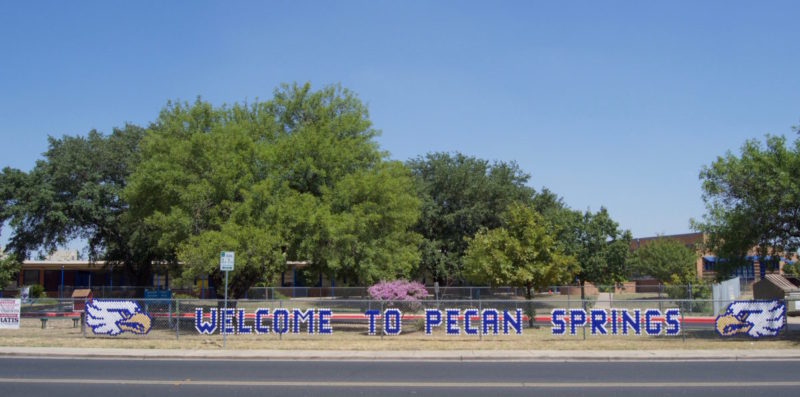Trustees and officials of the Austin Independent School District (AISD) are dreaming about how they could spend funds freed up by closing 12 schools, which they say would save the district on maintenance and overhead costs.
Behind the plan to close schools is a vision to move away from the current system of neighborhood schools toward a network of fewer, larger, more modern schools offering more services for students and better resources and training for teachers and staff.
Enhanced “cultural proficiency training” would be one area targeted for reinvestment if plans move forward, according to staff presentations made to school board trustees at a meeting last night.
Citing the “necessity for cultural profiency and inclusion,” AISD Chief of Business and Operations Nicole Conley Johnson said that savings from the school closures would be invested in cultural proficiency training for more than 6,000 teachers, counselors, campus staff, and district staff.
As described by Superintendent Paul Cruz and other officials, the training would go beyond existing efforts to promote “diversity and inclusion” and would be overseen by Equity Officer Dr. Stephanie Hawley.
In remarks to the board, Hawley cited the importance of “making sure that every child is in the presence of somebody who understands what it is to be culturally proficient.”
“If you’re in a dominant culture, you have to understand how your culture and how your use of power impacts another person. I think that this is one of the boldest steps that we are taking. Because we are talking about the reeducation of an entire system,” she said.
Another area for possible reinvestment is social justice programming. District staff explained to trustees that students would be provided with “new and expanded opportunities in… social justice.”
Dr. Elisabeth Goodnow, Associate Superintendent of Academics and Social and Emotional Learning, said that one idea was to have a “social justice center” that would build on AISD’s existing ethnic studies course. Students would be encouraged to read texts through a “political and economic and societal lens,” she said.
This kind of “deep study in a multi-cultural perspective” eventually could become a required course at high schools, Goodnow noted. “All of these do take money and investments.”
Other proposals shared at last night’s board meeting include expanding afterschool programs and using vacated school properties to provide subsidized housing to teachers. Conley Johnson noted that extending all schools’ hours to 6:30 p.m. with afterschool programs would make AISD more competitive against charter schools that have eaten into district enrollment.
According to Conley Johnson, enrollment losses over time have put pressure on district resources. Over 6,000 students have left since 2013, and the district projects a further loss of 7,000 students by 2029.
Although Austin’s population is growing, many of those moving to the city are young professionals without children, while those moving out – driven in part by rising costs and high property taxes – are families from long-established Black and Hispanic communities in central and east Austin.
It is there that AISD plans to close schools. Nine of twelve schools slated for closure are east of I-35 or just west of it, one is downtown, and two are south of the river. None of the schools slated for closure are north of 183 or west of Mopac.
According to Conley Johnson, 27% of the district’s schools are under-enrolled while 17% are overcrowded. “Under-enrolled schools constrain dollars available for programming,” she said.
Stephanie Hawley, AISD’s Equity Officer, described the upcoming school changes as an opportunity to correct Austin’s long history of racial inequity, though she did not spell out how exactly closing schools would accomplish this. She may have been alluding to the enhanced opportunities for the cultural proficiency training, which she would oversee.
Hawley described the draft scenarios as “not closures so much as change,” adding, “This is a great opportunity for us to interrupt and change the system… to start to undo the racism that’s doing so much damage to black and brown children.”
Not everyone at the board meeting was convinced that the proposed school closures would result in greater racial equity. District 2 Board Member Jayme Mathias, who represents Southeast Austin, said the school closures would disproportionately affect economically disadvantaged students.
“If small schools are inefficient in East Austin, are not small schools ineffecient elsewhere in Austin? How can it be that Zilker and Barton Hill are not on the list for that same reason?”
“Kowtowing to the most privileged is all over this document,” Mathias said, quoting a parent from his district.
Cruz responded in part that closing aging schools and transferring disadvantaged children would put them at better facilities with better programming. “We’re trying to get as many students as we can into 21st century learning spaces,” he said.
Cruz noted that the plans released last Thursday are not set in stone. But he also emphasized, “the status quo is not an option.” The school board is expected to vote on a final plan for school closures in November.
Photo, top: Pecan Springs Elementary, with a student population that is 32% African American and 59% Hispanic, is slated for closure under plans announced by AISD last week
